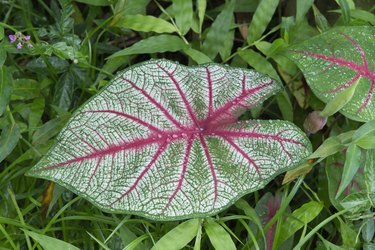
Caladiums (Caladium bicolor) are tropical foliage plants that grow from swollen roots known as tubers. Though caladiums may be left in the garden and grown as perennials in U.S. Department of Agriculture plant hardiness zones 9 and 10, they may actually do better when the tubers are removed from the wet, cold soil and stored in a cool, dry place through the winter.
Remove Tubers in Fall
Video of the Day
Using a garden spade, dig up your caladium tubers in the fall. Wait until the first frost strikes, when leaves have started to yellow but before they have lost all their color. Gradually withhold watering when the plant starts to naturally decline. Brush soil off of the tubers and leave them to dry, leaves still attached, in a semishaded area protected from the rain. Leave them for 10 to 21 days, when foliage has thoroughly dried out.
Video of the Day
Prepare Tubers for Storage
Cut the dry leaves off the tubers using scissors or pruning shears, and brush off any remaining dirt or debris from the tubers. Cut out any rotten parts of the tuber and use a small paintbrush or cotton swab to coat the wounds with a fungicide bulb dust. You can also help prevent rot on healthy tubers by putting them into a paper bag partially filled with fungicide bulb dust and shaking the bag vigorously. Use gloves while handling the fungicide-covered tubers. Wash your hands thoroughly with soap and water and store unused fungicide in a cool, secure location away from pets, children and food items.
Store in a Dry Place
Loosely pack the tubers in dry peat moss, sphagnum moss or vermiculite, or place them in a mesh orange or onion bag. Spread tubers out so that they do not touch each other. Keep them stored at a temperature between 50 to 60 degrees Fahrenheit in a dry environment. An unheated garage may be too cold. Do not keep tubers in the refrigerator.
Check for Rot
Overwintered tubers may be planted in the garden in late spring, once soil has warmed to about 70 degrees Fahrenheit. Plant tubers knobby side up, about 2 to 3 inches deep in the soil and spaced 8 to 12 inches apart. Choose a location with partial shade and well-draining, moist, rich soil. Do not plant tubers that have succumbed to tuber rot, a fungal decay that darkens and softens tubers. Only plant disease-free tubers. Even with disease-free tubers, second-year foliage is generally not as showy as first-year foliage according to the Clemson Cooperative Extension, which notes that you may have better results when overwintering the tubers of white-foliaged cultivars.
- Clemson Cooperative Extension: Caladiums
- University of Florida Extension: Caladiums
- North Carolina State University: Caladiums for the Home Landscape
- Missouri Botanical Garden: Caladium Bicolor
- Mississippi State University Extension: Caladiums for the Landscape
- Purdue University: Winter Storage of Geranium, Canna, Gladiolus, Caladium, and Begonia